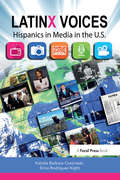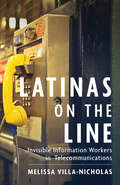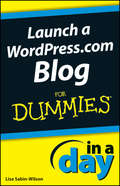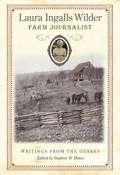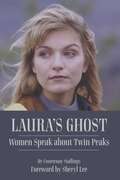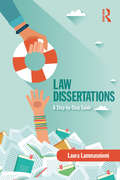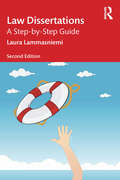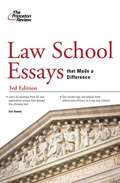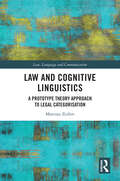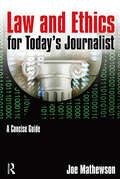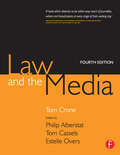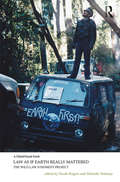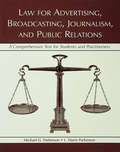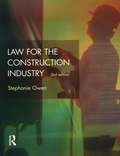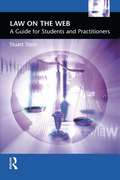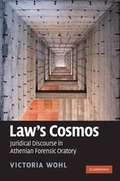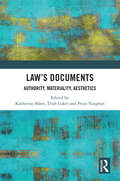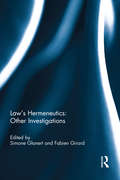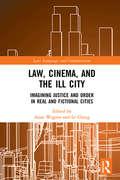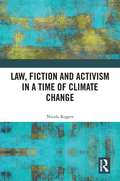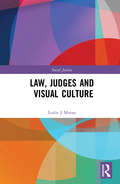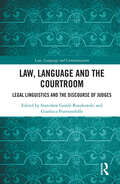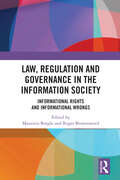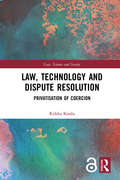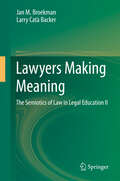- Table View
- List View
LatinX Voices: Hispanics in Media in the U.S
by Katie Coronado Erica KightLatinX Voices is the first undergraduate textbook that includes an overview of Hispanic/LatinX Media in the U.S. and gives readers an understanding of how media in the United States has transformed around this audience. Based on the authors’ professional and research experience, and teaching broadcast media courses in the classroom, this text covers the evolving industry and offers perspective on topics related to Latin-American areas of interest. With professional testimonials from those who have left their mark in print, radio, television, film and new media, this collection of chapters brings together expert voices in Hispanic/LatinX media from across the U.S., and explains the impact of this population on the media industry today.
Latinas on the Line: Invisible Information Workers in Telecommunications (Latinidad: Transnational Cultures in the United States)
by Melissa Villa-NicholasLatinas on the Line provides a compelling analysis and historical and theoretical grounding of the oral histories, never before seen, of Latina information workers in the Bell System from their entrance in 1973 to their retirements by 2015. Author Melissa Villa-Nicholas demonstrates the importance of Latinas of the field of telecommunications through their own words and uses supporting archival research to provide an overview of how Latinas engage and remember a critical analysis of their work place, information technologies, and the larger globalized economy and shifting borderlands through their intersectional identities as information workers. The book offers a rich and engaging portrait of the critical history of Latinas in telecommunications, from their manual to automated to digitized labor.
Launch a WordPress.com Blog In A Day For Dummies
by Lisa Sabin-WilsonLet this 96-page e-book show you the quick and easy way to launch your blogWordPress is among the most popular blogging platforms. If you're ready to start your WordPress blog, this handy e-book will get you going. It gets right to the point, showing you how to create a WordPress.com account, navigate WordPress.com and use the Dashboard, customize blog settings, use themes, organize your blog, and dress it up with widgets and upgrades. A special link to dummies.com provides additional information, including video tutorials that boost your blog IQ. Read it today and have your blog up and running tomorrow!This highly focused e-book gives you the straight line on setting up a blog using WordPress.com Walks you through creating your account, navigating WordPress.com and using the Dashboard, choosing a theme for your blog, customizing settings, and organizing your blog by categoriesProvides further materials, including video tutorials on establishing settings and privacy controls, plus step-by-step instructions for setting up your blogLaunch a WordPress.com Blog In A Day For Dummies is the quick and easy way to join the blogosphere with WordPress.com.
Laura Ingalls Wilder, Farm Journalist: Writings from the Ozarks
by Laura Ingalls Wilder Steven W. Hines(front cover flap) Laura Ingalls Wilder WRITINGS FROM THE OZARKS Edited by Stephen W. Hines Before Laura Ingalls Wilder found fame with her Little House books, she made a name for herself with short nonfiction pieces in magazines and newspapers. Read today, these pieces offer insight into her development as a writer and depict farm life in the Ozarks- and also show us a different Laura Ingalls Wilder from the woman we have come to know. This volume collects essays by Wilder that originally appeared in the Missouri Ruralist between 1911 and 1924. Building on the initial compilation of these articles under the title Little House in the Ozarks, this revised edition marks a more comprehensive collection by adding forty-two additional Ruralist articles and restoring passages previously omitted from other articles.
Laura's Ghost: Women Speak About Twin Peaks
by Courtenay StallingsThis incredibly powerful book by media professor Courtenay Stallings explores the dark side of Twin Peaks through interviews with fans of the show who've experienced trauma in their own lives and worked through it with assistance from the character of Laura Palmer. In 1990, the groundbreaking television series Twin Peaks, cocreated by David Lynch and Mark Frost, opened with a murder mystery when a homecoming queen washed up on a rocky beach. Laura Palmer&’s character began as a plot device that triggered a small town to face its fractured self. After three seasons and a film, Laura Palmer is no longer just a plot device. Twin Peaks allows the audience to get to know the victim—a complex woman finding her strength while enduring incredible trauma. Laura&’s Ghost: Women Speak about Twin Peaks explores Laura&’s legacy through the perspectives of women in the fan community and women involved in the show. Actor Sheryl Lee examines the challenges of playing Laura Palmer. Filmmaker Jennifer Lynch discusses writing Laura&’s backstory in The Secret Diary of Laura Palmer. Grace Zabriskie argues about the complicity of Sarah Palmer, Laura&’s mother. Sabrina S. Sutherland, executive producer of Twin Peaks, talks about Laura&’s legacy. Women in the Twin Peaks fan community share their powerful and heart-wrenching stories of survival and what Laura Palmer means to them. This book is a reckoning in which women speak about trauma, mischief, humor, sexuality, strength, weakness, wickedness, and survival.
Law Dissertations: A Step-by-Step Guide
by Laura LammasniemiLaw Dissertations: A Step-by-Step Guide provides you with all the guidance and information you need to complete and succeed in your LLB, LLM or law-related dissertation. Written in a simple, clear format and with plenty of tools to help you to put the theory into practice, Laura Lammasniemi will show you how to make writing your law dissertation easy, without compromising intellectual rigour. As well as explaining the process of research and outlining the various legal methodologies, the book also provides practical, step-by-step guidance on how to formulate a proposal, research plan, and literature review. Unlike other law research skills books, it includes a section on empirical research methodology and ethics for the benefit of students who are studying for a law-related degree. Packed full of exercises, worked examples and tools for self-evaluation, this book is sure to become your essential guide, supporting you on every step of your journey in writing your law dissertation.
Law Dissertations: A Step-by-Step Guide
by Laura LammasniemiLaw Dissertations: A Step-by-Step Guide provides law students with all the guidance and information they need to complete and succeed in their LLB, LLM or law-related dissertation. Written in an accessible, clear format and with plenty of tools to help put the theory into practice, Laura Lammasniemi will show students how to make writing a law dissertation easy, without compromising intellectual rigour. The primary aim of this book is to tackle the issues that cause anxiety to law students undertaking a dissertation so that they can focus on the research that you find exciting. As well as explaining the process of research and outlining the various legal research approaches, the book also provides practical, step-by-step guidance on how to formulate a proposal, research plan, and literature review. The second edition expands guidance to LLM and Masters students, and provides up-to-date guidance on how to complete your project using both online resources and remotely. Unlike other law research skills books, Law Dissertations: A Step-by-Step Guide includes a section on empirical research methodology and ethics for the benefit of students who are studying for a Masters in law. Packed full of exercises, worked examples, and tools for self-evaluation, this book is sure to become an essential guide for law students, supporting them on every step of their dissertation journey.
Law School Essays That Made a Difference
by Eric OwensOne of the best ways to stand out in a crowd of applicants to law school is to write an exceptional personal statement. Law School Essays That Made a Difference, 3rd Edition, contains 70 real application essays as well as interviews with admissions pros and with students who've been through the process and made it to law school.
Law and Cognitive Linguistics: A Prototype Theory Approach to Legal Categorisation (ISSN)
by Mateusz ZeifertThis book advances the prototype theory of categorisation within a legal context. The work adopts a multidisciplinary approach and draws on insights from cognitive psychology, cognitive linguistics, and analytic philosophy to discuss semantic problems present in law. Designed as a bridge between cognitive linguistics and legal theory, it argues that categorisation is a crucial cognitive operation for the application of law and that theories of categorisation are relevant to legal theory. It makes the case that the prototype approach is better suited than more formal approaches usually utilised in jurisprudence to explaining many familiar linguistic problems found in law, such as vagueness, polysemy, the flexibility of meaning, the generality of language, context dependence of meaning, linguistic indeterminacy, and so on. The book focuses on problems of semantic analysis in law, both in concrete cases, that is, particular cases before courts, and, at the theoretical level, on methods of statutory interpretation. It will be a valuable resource for academics and researchers working in the areas of Law and Language, Legal Theory, Legal Philosophy, and Legal Linguistics.
Law and Ethics for Today's Journalist: A Concise Guide
by Joe MathewsonLaw and Ethics for Today's Journalist offers aspiring and working journalists the practical understanding of law and ethics they must have to succeed at their craft. Instead of covering every nuance of media law for diverse communications majors, Mathewson focuses exclusively on what's relevant for journalists. Even though media law and media ethics are closely linked together in daily journalistic practice, they are usually covered in separate volumes. Mathewson brings them together in a clear and colourful way that practicing journalists will find more useful. Everything a journalist needs to know about legal protections, limitations, and risks inherent in workaday reporting is illustrated with highlights from major court opinions.Mathewson advises journalists who must often make ethical decisions on the spot with no time for the elaborate, multi-faceted analysis. The book assigns to journalists the hard decisions on ethical questions such as whether to go undercover or otherwise misrepresent themselves in order to get a big story. The ethics chapter precedes the law chapters because ethical standards should underlie a journalist's work at all times. There may be occasions when ethics and law are not parallel, thus calling for the journalist to make a personal judgment. Law and Ethics for Today's Journalist is user-friendly, written in clear, direct, understandable language on issues that really matter to a working journalist. Supplementary reading of the actual court cases is recommended and links to most cases are provided in the text. The text includes a fine (but purposely not exhaustive) bibliography listing important and useful legal cases, including instructive appellate and trial court opinions, state as well as federal.
Law and the Media: An Everyday Guide For Professionals (Journalism Media Manual Ser.)
by Estelle Overs Tom Crone Tom CasselsTom Crone's classic text has been thoroughly revised by an impressive team of legal experts. It provides an essential source of reference for the key legal issues encountered by those who work in the media such as journalists, editors and producers, as well as media lawyers. Topics covered include:Protection of ReputationCopyright and Rights ClearanceNew MediaBreach of Confidence and PrivacyThe Data Protection Act 1998Reporting Restrictions, Contempt of Court and Protection of Journalistic SourcesThe Freedom of Information Act 2000 and Official SecretsProfessional Regulatory Bodies and AdvertisingThe Human Rights Act 1998The Law in Scotland and the United States of AmericaComprehensive supplementary reference material is also provided, including a glossary of legal terms, addresses, telephone numbers and web sites of professional bodies, and specimen agreements including interview agreements and moral rights waivers.With contributions from: Terence Bergin, Marietta Cauchi, Jane Colston, Mark Cranwell, Charles de Fleurieu, Simon Dowson-Collins, David Green, Peter Grundberg, Rebecca Handler, Joanna Ludlam, Rosalind McInnes, Hugh Tomlinson and John Wadham.
Law as if Earth Really Mattered: The Wild Law Judgment Project (Law, Justice and Ecology)
by Nicole Rogers Michelle MaloneyThis book is a collection of judgments drawn from the innovative Wild Law Judgment Project. In participating in the Wild Law Judgment Project, which was inspired by various feminist judgment projects, contributors have creatively reinterpreted judicial decisions from an Earth-centred point of view by rewriting existing judgments, or creating fictional judgments, as wild law. Authors have confronted the specific challenges of aligning existing Western legal systems with Thomas Berry’s philosophy of Earth jurisprudence through judgment writing and rewriting. This book thus opens up judicial decision-making and the common law to critical scrutiny from a wild law or Earth-centred perspective. Based upon ecocentric rather than human-centred or anthropocentric principles, Earth jurisprudence poses a unique critical challenge to the dominant anthropocentric or human-centred focus and orientation of the common law. The authors interrogate the anthropocentric and property rights assumptions embedded in existing common law by placing Earth and the greater community of life at the centre of their rewritten and hypothetical judgments. Covering areas as diverse as tort law, intellectual property law, criminal law, environmental law, administrative law, international law, native title law and constitutional law, this unique collection provides a valuable tool for practitioners and students who are interested in learning more about the emerging ecological jurisprudence movement. It helps us to see more clearly what a new system of law might look like: one in which Earth really matters.
Law for Advertising, Broadcasting, Journalism, and Public Relations: A Comprehensive Text For Students And Practitioners (Routledge Communication Series)
by Michael G. Parkinson L. Marie ParkinsonThis exceptional new text offers an up-to-date and integrated approach to communication law. Written by two practicing attorneys with extensive experience teaching the communication law course, Law for Advertising, Broadcasting, Journalism, and Public Relations covers the areas of communication law essential and most relevant for readers throughout the communication curriculum. Its integrated approach will serve students and practitioners in advertising and public relations as well as those in journalism and electronic media.Providing background to help readers understand legal concepts, this comprehensive communication law text includes an introduction to the legal system; covers legal procedures, structures, and jurisdictions; discusses the First Amendment and electronic media regulations; and considers issues of access. Additional material includes: *intellectual property law; *employment and agency law, with explanations of how these laws create obligations for mass communication professionals and their employees; *commercial communication laws; and *special laws and regulations that impact reporters, public relations practitioners, and advertisers who deal with stock sales.Special features of this text include:*Magic Words and Phrases--defining legal terms;*Cases--illustrating key points in each chapter;*Practice Notes--highlighting points of particular interest to professional media practices;*Instructions on finding and briefing cases, with a sample brief; and*Examples of legal documents and jury instructions.This text is intended as an introduction to communication law for students and practitioners in mass communication, journalism, advertising, broadcasting, telecommunications, and public relations.
Law for the Construction Industry (Chartered Institute of Building)
by Stephanie Owen J.R. LewisLaw for the Construction Industry provides a comprehensive introduction to the English legal system and basic contract law for those involved in the construction industry. It covers the level 2 module on legal studies of The CIOB's Education Framework and is officially sanctioned by The CIOB as the recognised book for that module. The book assumes no previous knowledge of English law.The second edition has been brought fully up-to-date with the latest legal changes. It explains basic contract law and gives the reader an understanding of employment and consumer law whilst placing law in the context of the construction industry throughout.Law for the Construction Industry is a core textbook for the CIOB level 2 module on legal studies, as well as BTEC HNC/D and degree courses in building and construction management.
Law on the Web: A Guide for Students and Practitioners
by Stuart SteinLaw on the Web is ideal for anyone who wants to access Law Internet resources quickly and efficiently without becoming an IT expert. The emphasis throughout is on the location of high quality law Internet resources for learning, teaching and research, from among the billions of publicly accessible Web pages.The book is structured so that it will be found useful by both beginners and intermediate level users, and be of continuing use over the course of higher education studies.In addition to extensive coverage on locating files and Web sites, Part III provides a substantial and annotated list of high quality resources for law students.
Law's Cosmos
by Victoria WohlRecent literary-critical work in legal studies reads law as a genre of literature, noting that Western law originated as a branch of rhetoric in classical Greece and lamenting the fact that the law has lost its connection to poetic language, narrative, and imagination. But modern legal scholarship has paid little attention to the actual juridical discourse of ancient Greece. This book rectifies that neglect through an analysis of the courtroom speeches from classical Athens, texts situated precisely at the intersection between law and literature. Reading these texts for their subtle literary qualities and their sophisticated legal philosophy, it proposes that in Athens' juridical discourse literary form and legal matter are inseparable. Through its distinctive focus on the literary form of Athenian forensic oratory, Law's Cosmos aims to shed new light on its juridical thought, and thus to change the way classicists read forensic oratory and legal historians view Athenian law.
Law's Documents: Authority, Materiality, Aesthetics
by Katherine Biber, Trish Luker and Priya VaughanIlluminating their breadth and diversity, this book presents a comprehensive and multidisciplinary view of legal documents and their manifold forms, uses, materialities and meanings. In 1951, Suzanne Briet, a librarian at the Bibliotheque Nationale in Paris, famously said that an antelope in a zoo could be a document, thereby radically changing the way documents were analysed and understood. In the fifty years since this pronouncement, the digital age has introduced a potentially limitless range of digital and technological forms for the capture and storage of information. In their multiplicity and their ubiquity, documents pervade our everyday life. However, the material, intellectual, aesthetic and political dimensions and effects of documents remain difficult to pin down. Taking a multidisciplinary and international approach, this collection tackles the question, what is a legal document?, in order to explore the material, aesthetic and intellectual attributes of legal documentation; the political and colonial orders reflected and embedded in documents; and the legal, archival and social systems which order and utilise information. As well as scholars in law, documentary theory, history, Indigenous studies, art history and design theory and practice, this book will also appeal to those working in libraries, archives, galleries and museums, for whom the ongoing challenges of documentation in the digital age are urgent and timely questions.
Law's Hermeneutics: Other Investigations
by Fabien Girard Simone GlanertBringing together leading academics hailing from different cultural and scholarly horizons, this book revisits legal hermeneutics by making particular reference to philosophy, sociology and linguistics. On the assumption that theory has much to teach law, that theory motivates and enables, the writings of such intellectuals as Martin Heidegger, Hans-Georg Gadamer, Jacques Derrida, Paul Ricœur, Giorgio Agamben, Jürgen Habermas, Ronald Dworkin and Ludwig Wittgenstein receive special consideration. As it explores the matter of reading the law and as it inquires into the emergence of meaning within the dynamic between reader and text against the background of the reader’s worldly finiteness, this collection of essays wishes to contribute to an improved appreciation of the merits and limits of law’s hermeneutics which, it argues, is emphatically not to be reduced to a simple tool for textual exegesis.
Law, Cinema, and the Ill City: Imagining Justice and Order in Real and Fictional Cities (Law, Language and Communication)
by Anne Wagner Le ChengThis book uses film and television as a resource for addressing the social and legal ills of the city. It presents a range of approaches to view the ill city through cinematic and televisual characterization in urban frameworks, political contexts, and cultural settings. Each chapter deconstructs the meaning of urban space as public space while critically generating a focus on order and justice, exploring issues such as state disorder, lawlessness, and revenge. The approach presents a careful balance between theory and application. The original and novel ideas presented in this book will be essential reading for those interested in the presentation of law and place in cultural texts such as film.
Law, Fiction and Activism in a Time of Climate Change
by Nicole RogersThe book examines the narratives of climate change which have developed and which are currently evolving in three areas: law, fiction and activism. Narratives of climate change generated by litigants, judges, writers of fiction and activists are having, and will have, a profound effect on the way we respond to the climate change crisis. Acknowledging the prevalence of unreliable narrators, this book explores the reliability and significance of different forms of climate narrative. The author analyses overlapping themes and points of intersection, considering the recurrent motif of the trickster, the prominence of the child, the significance and ongoing viability of the rights discourse, and the increasingly prevalent emergency framing with its multiple implications for law’s empire. She asks how law, fiction and activism measure up as textual and performative fora for telling the story of climate change and anticipating a climate-changed future. And, in addition, how can they help foster transformative narratives which empower us to confront the climate change crisis? This highly topical, cross-disciplinary work will be of interest to anyone concerned about the growing climate emergency and makes a valuable contribution to climate law, environmental law, the environmental humanities and ecocriticism.
Law, Judges and Visual Culture (Social Justice)
by Leslie J MoranLaw, Judges and Visual Culture analyses how pictures have been used to make, manage and circulate ideas about the judiciary through a variety of media from the sixteenth century to the present. This book offers a new approach to thinking about and making sense of the important social institution that is the judiciary. In an age in which visual images and celebrity play key roles in the way we produce, communicate and consume ideas about society and its key institutions, this book provides the first in-depth study of visual images of judges in these contexts. It not only examines what appears within the frame of these images; it also explores the impact technologies and the media industries that produce them have upon the way we engage with them, and the experiences and meanings they generate. Drawing upon a wide range of scholarship – including art history, film and television studies, and social and cultural studies, as well as law – and interviews with a variety of practitioners, painters, photographers, television script writers and producers, as well as court communication staff and judges, the book generates new and unique insights into making, managing and viewing pictures of judges. Original and insightful, Law, Judges and Visual Culture will appeal to scholars, postgraduates and undergraduates from a variety of disciplines that hold an interest in the role of visual culture in the production of social justice and its institutions.
Law, Language and the Courtroom: Legal Linguistics and the Discourse of Judges (Law, Language and Communication)
by Gianluca Pontrandolfo Stanisław Goźdź-RoszkowskiThis book explores the language of judges. It is concerned with understanding how language works in judicial contexts. Using a range of disciplinary and methodological perspectives, it looks in detail at the ways in which judicial discourse is argued, constructed, interpreted and perceived. Focusing on four central themes - constructing judicial discourse and judicial identities, judicial argumentation and evaluative language, judicial interpretation, and clarity in judicial discourse - the book’s ultimate goal is to provide a comprehensive and in-depth analysis of current critical issues of the role of language in judicial settings. Contributors include legal linguists, lawyers, legal scholars, legal practitioners, legal translators and anthropologists, who explore patterns of linguistic organisation and use in judicial institutions and analyse language as an instrument for understanding both the judicial decision-making process and its outcome. The book will be an invaluable resource for scholars in legal linguistics and those specialising in judicial argumentation and reasoning ,and forensic linguists interested in the use of language in judicial settings.
Law, Regulation and Governance in the Information Society: Informational Rights and Informational Wrongs
by Roger Brownsword Maurizio BorghiThis edited collection seeks to map the landscape of contemporary informational interests, to evaluate a range of recognised and putative rights and wrongs associated with modern information societies, and to consider how law, regulation, and governance should be deployed in response. New technologies and new applications constantly disrupt our values, our framing of our world, and our sense of where we are and who we are. In our ‘information societies’, we entertain mixed hopes and expectations, as well as significant fears and concerns. At the root of these, there are a number of informational interests, on the basis of which certain rights are claimed and particular wrongs denounced. This book addresses these interests, considering them as relating primarily to the integrity of the informational eco-system, to the accessibility, accuracy, and authenticity of public information, and to our individual ability to control the outward and inward flows of information that relates directly to ourselves. Covering a wide range of subjects, the book’s interrogation of our contemporary information society is oriented around two questions: first, whether the information society in which we live is the kind of society that we think it should be and, second, if not, what we can reasonably expect law, regulation and governance to do in providing the basis for improving it. This book will be of considerable interest to those working at the intersection of law and technology, as well as others concerned with the legal, political, and social aspects of our information society.
Law, Technology and Dispute Resolution: The Privatisation of Coercion (Law, Science and Society)
by Riikka KouluThe use of new information and communication technologies both inside the courts and in private online dispute resolution services is quickly changing everyday conflict management. However, the implications of the increasingly disruptive role of technology in dispute resolution remain largely undiscussed. In this book, assistant professor of law and digitalisation Riikka Koulu examines the multifaceted phenomenon of dispute resolution technology, focusing specifically on private enforcement, which modern technology enables on an unforeseen scale. The increase in private enforcement confounds legal structures and challenges the nation-state’s monopoly on violence. And, in this respect, the author argues that the technology-driven privatisation of enforcement – from direct enforcement of e-commerce platforms to self-executing smart contracts in the blockchain – brings the ethics of law’s coercive nature out into the open. This development constitutes a new, and dangerous, grey area of conflict management, which calls for transparency and public debate on the ethical implications of dispute resolution technology.
Lawyers Making Meaning....
by Jan M. Broekman Larry Catà BackerThis book present a structure for understanding and exploring the semiotic character of law and law systems. Cultivating a deep understanding for the ways in which lawyers make meaning--the way in which they help make the world and are made, in turn by the world they create --can provide a basis for consciously engaging in the work of the law and in the production of meaning. The book first introduces the reader to the idea of semiotics in general and legal semiotics in particular, as well as to the major actors and shapers of the field, and to the heart of the matter: signs. The second part studies the development of the strains of thinking that together now define semiotics, with attention being paid to the pragmatics, psychology and language of legal semiotics. A third part examines the link between legal theory and semiotics, the practice of law, the critical legal studies movement in the USA, the semiotics of politics and structuralism. The last part of the book ties the different strands of legal semiotics together, and closely looks at semiotics in the lawyer's toolkit--such as: text, name and meaning.
